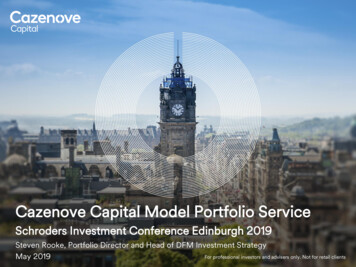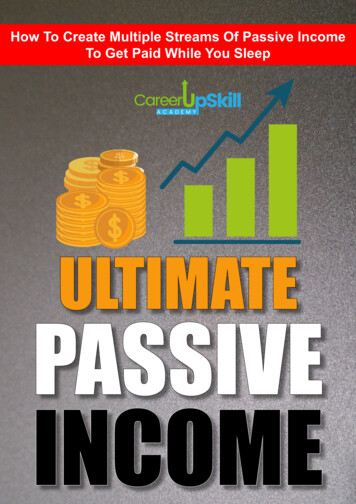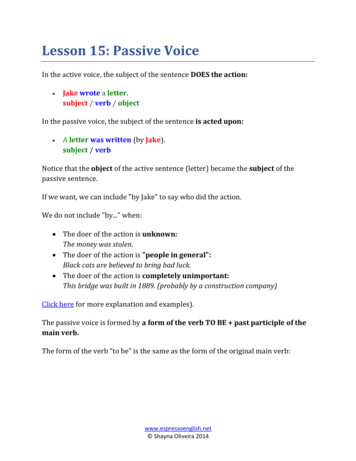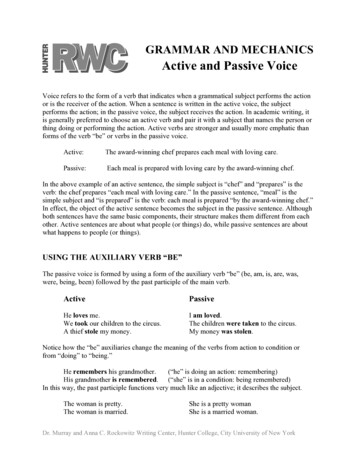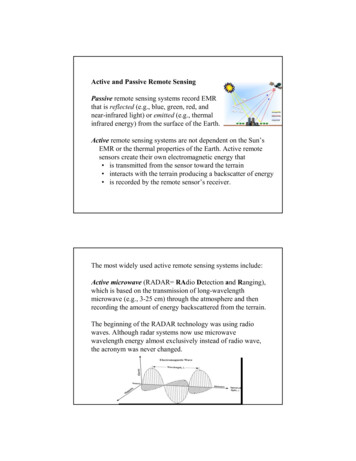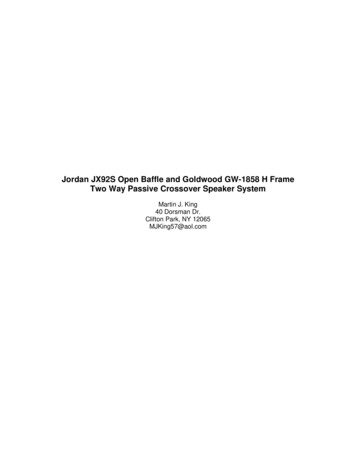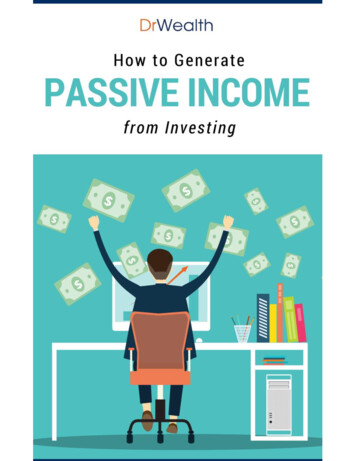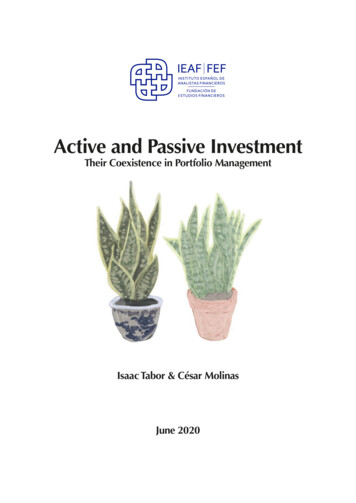
Transcription
EActive and Passive InvestmentTheir Coexistence in Portfolio ManagementIsaac Tabor & César MolinasJune 2020
Isaac Tabor is an economist. He currently dedicates his time to consulting andteaching. His profesional trajectory includes investment banking, asset management and the energy sector.César Molinas is a mathematician, economist, consultant and financier. He hasworked in academia, in the public administration, in investment banking and inconsulting, He has already published 10 books on mathematics, economics, history, politics and international relations.ISBN: 978-84-09-21121-0Depósito Legal: M-15455-2020Editor: Fundación de Estudios FinancierosCover Design: Daniela Tabor
IndexIntroduction and main conclusions.71. The active versus passive investment dilemma: a historicalperspective. 111.1 Financial markets, middle classes and pensions. 111.2 The financial disintermediation of industrial capitalism. 111.3 Expanding middle classes. 121.4 Survival pyramids become rectangles thus threatening pensions. 121.5 Active versus passive investment: a recent dilemma. 131.6 From mutual funds to ETFs. 131.7 The decrease of market liquidity and the increase in passiveinvestment since 2008. .151.8 Active and passive investment: the point of view of investors. 151.9 Active and passive investment: the point of view of asset managers. 161.10 Active and passive investment: the point of view of regulators. 162. The active versus passive investment dilemma: a theoreticalperspective. 192.1 A theoretical framework combining active and passiveinvestment strategies. 192.2 The Fundamental Law of Active Management. 203
2.3 The relevance of breadth. 212.4 Skill and breadth. 212.5 The Fundamental Law is additive. 222.6 Are there truly independent investment strategies?. 232.7 A generalized view of the Fundamental Law of ActiveManagement. .232.8 The proof of the pudding for active management: BerkshireHathaway. .243. Stock Market Indices. 273.1 A bit of history. 273.2 A densely populated world. 273.3 A complex and technical world. 283.4 Indices and benchmarks. 303.5 A profitable industry. 303.6 Homemade indices. 313.7 Regulatory concerns. 313.8 In-house competition to index providers. 323.9 Beyond profitability. 334. Passive and exchange traded funds. 354.1 Passive funds. 354.2 Exchange traded funds (ETFs). 354.3 How do ETFs work. 364.4 Creation of ETF shares. 374.5 The Primary Market for ETFs. 384.6 The Secondary Market. 414.7 A further development: Non-transparent Active ETFs. 424
Index5. How do ETFs Track indices?. 455.1 Physical replication. 455.2 Representative or Statistical Sampling. 465.3 Synthetic ETFs. 465.3 The ‘Closet-Trackers’ Problem. 466. Costs of Investment Funds: Active and Passive. 557. Expenses trend down, ETFs share of the market climbs. 637.1 Competition unleashed. 637.2 The Swift Expansion of ETFs. 658. E TFs: Allocation of Capital, Competition and CorporateGovernance. 718.1. Do ETFs threaten an efficient allocation of capital?. 718.2. Common ownership, Passive ETFs and Competition. 728.3 ETFs and Corporate Governance. 758.4 ETFs: Passive Investment, Governance and Activism. 809. A Few Observations on ETFs and Market Stability. 8510. Final remarks. 89Glossary . 91References. 955
INTRODUCTION AND MAIN CONCLUSIONSIn this report we discuss the causes and the consequences of the extraordinarygrowth experienced by passive investment funds -especially, but not exclusively,Exchange Traded Funds (ETFs)- in the last twenty years, an expansion that hasbeen particularly intense in the last decade. This growth has changed dramatically the landscape of the investment funds industry: competition and transparency have increased and costs for the investor have fallen. Traditional, activeinvestment funds compete with each other in a monopolistic competition1 framework: each of them claiming to be different from and smarter than the rest. Theemergence of passive, plain vanilla, inexpensive investment vehicles -there aremore than 5,000 ETFs at the time of writing this report- has put the traditionalframework to the test.We have divided the work in 10 sections.In Section 1 we put forward a historical explanation of the democratization offinancial investment in the Western world. This process stems, on the one hand,from the emergence of middle classes with saving possibilities and, on the otherhand, from the development of financial markets and instruments that made itfeasible and easy for individuals and institutions to gain access to them. Historiamagistra vitae est.In Section 2 we present a theoretical model that brings some discipline to theinvestment processes of both individuals and institutions. This methodology isbased on the idea that all financial investors should separate their investmentsbetween a strategic portfolio, aimed at getting whole market returns, and several1See the Monopolistic Competition entry in the Glossary7
Active and Passive Investmentsatellite portfolios, aimed at getting pure alpha. In this framework we discuss theFundamental Law of Active Management and assess the roles of skill and luck intop active manager’s performance. The data show very weak persistence in timeof top performances, so luck may have a greater role that commonly assumed indetermining who the top performers are at a given time.In Section 3 we describe some key features of the index-producers industry thatprovides benchmarks nor just for passive investors but for active investors aswell. The number of indices reported by the Index Industry Association is trulymind-blowing: some 3.2 million were kept updated by mid-2018. We report inthis section some regulatory concerns that have been raised by IOSCO regardingthe kind of indices that are suitable to be used by collective investment schemes-an issue of transparency- and the problems raised by homemade indices -an issue of conflict of interests-. In any case, the index industry is very profitable andshows a high degree of concentration: the three largest index providers have amarket share of 70% and a profit margin of 65%.In Section 4 we deal with passive funds and, especially, their more relevant investment vehicle: Exchange Traded Funds (ETFs). We provide a thorough description of how ETFs work. We start from their creation as an investment vehicle by a sponsor and continue by describing how ETFs’ shares are created andredeemed. These are complex processes. We describe the primary and secondarymarkets for ETFs and how they manage to disclose the Intraday Net Asset Value(INAV) of the fund every 15 seconds during the trading session. We also refer tothe recently authorized Non-Transparent Active ETFs and comment on how theircost structure may evolve.In Section 5 we address the issue of how ETFs track their indices. This is nota straightforward issue. The method chosen depends, among other factors, onthe liquidity and cost of trading the underlying securities. ETFs can replicatetheir reference index physically, but that may prove to be difficult and expensive;they can do it by statistical sampling, which always incurs in tracking errors thatcan become significant; or they may use swaps, funded or unfunded, to imitatethe index synthetically. This section also discusses the so-called “closet-trackers” problem, i.e. purported active asset managers that actually implement anindex-tracking strategy.In Section 6 we discuss the contentious issue of the costs of investment funds.8
Introduction and main conclusionsThis is a fiendishly complex topic. Comparisons between active funds are verydifficult and may be plainly impossible to make. Commonly used ratios as theExpense Ratio or the Total Expense Ratio typically do not include all expensesthat are eventually charged to the client. Heterogeneity in the active investmentfunds universe fogs all possible comparisons. Passive funds, especially ETFs,have a much more transparent cost structure, given that most transaction costsare shifted from the fund to the investor, who pays for them directly.In Section 7 we examine the reasons why investment funds’ expenses are trending down. And down they trend indeed! Management fees charged by open-ended funds have fallen 50% between 2000 and 2018. This fall is driven by clientsbecoming much more sensitive to costs and being ready to move from expensivefunds to cheaper ones. In this section we also provide a graphic description of theeffects of this cost reduction on the world of investment funds.In Section 8 we come to grips with another controversial topic. Does the concentration of shares of public companies in holdings of ETFs undermine competition? Is the concentration of voting rights in ETFs’ management a negativefor the economy? We discuss these problems in an Agent-Principal framework,finding no meaningful adverse effects.In Section 9, we address the controversial issue of whether or not gigantic ETFspose significant challenges to financial stability. Concerns about this were raisedas early as 2011 regarding three main areas: 1) the reliance of synthetic ETFs onderivatives (swaps), (2) their investments in illiquid assets and (3) their extensiveuse of securities lending. After examining these issues with some detail we findno evidence of ETFs rising risks to financial stability beyond what other financialinstruments and institutions have already been doing for decades.Finally, in Section 10, as concluding remarks to this report, we return to the financial investment model spelled out in Section 2 and make the case for a combinationof strategic and tactical portfolios. Investors in financial assets may be classified intwo broad classes. In the first group we find those who do nor care for the subtletiesof investment processes. These investors should concentrate in passive, inexpensive investment vehicles. The second group of investors does care about investment decisions, market intelligence and a close relationship with fund managers.They should have active management vehicles in their portfolios and be preparedto pay higher fees.9
1. THE ACTIVE VERSUS PASSIVE INVESTMENT DILEMMA:A HISTORICAL PERSPECTIVE1.1 Financial markets, middle classes and pensions.Current ideas on financial investment are rooted in the historical development offinancial markets, in the growth of social middle classes with actual possibilitiesof saving and investing, and in the extension of life expectancy, not just in developed countries but also in the developing world. These three processes haveproceeded in parallel since the last decades of the 19th century. Previously, richpeople invested in property, agrarian, real estate or industrial. Nowadays property is no longer the sole means of accumulating wealth.1.2 The financial disintermediation of industrial capitalism.The first stock market was founded in Amsterdam in 1602. It operated in themansion of the Van der Buërse family (hence the alternative name of Bourses forstock markets). In London the stock market was officially founded in 1801 butthere is strong evidence that already in 1695 there were more than 140 enterprises trading their own stock in the coffee shops around Exchange Alley in order toget long term financing. As the 19th century went on several stock exchanges appeared in industrializing countries aiming at achieving the best possible financialworld: one in which firms could get long term financing using short term investments made by private investors. This financial alchemy opened the possibilityof accumulating financial, liquid wealth to both the upper and the burgeoningmiddle classes. In the 20th century the capitalization of stock markets grew athastening pace.11
Active and Passive Investment1.3 Expanding middle classes.Contrary to Karl Marx’s expectations, capitalism and industrialization did notlead to growing polarization between capitalists and proletarians. There weretwo important reasons for his prediction’s failure. First, industrial capitalismneeded ever more qualified, educated workers, and higher productivity led tohigher compensation. This resulted in average salaries moving away and upfrom mere subsistence levels thus creating the possibility of saving for thebetter-paid workers. Second, in the 19th century several European countries-Germany, Italy and others- experienced national construction processes thatrequired a lot of newly created social cohesion around the emerging idea ofnation. These processes needed middle classes that related their own prosperity to the consolidation of the new nations and, also, the establishment of thefoundations of the welfare state to keep the working classes on board. Thesetwo processes resulted in growing access to real estate property and to financialmarkets, especially the stock markets. In Western countries liberal democraciesbecame amiable to the popular capitalism doctrine.1.4 Survival pyramids become rectangles thus threatening pensions.There has never been such a thing as a “population pyramid” because they areflat figures: they should be named “population triangles”. Having said that,in the 20th century these triangles morphed into rectangles in many Westerncountries and, in some places, even reshaped into inverted triangles. This“rectanglization” of survival, which can be seen in the 21st century in mostcountries, results from three different but related processes. First, the sharpfall in infant mortality due to improved public hygiene regulation, on theone hand, and by the discovery of antibiotics, on the other. Second, the evensharper fall of the fertility rate in response to the reduction of infant mortality. And third, the worldwide increase of life expectancy: in the UK lifeexpectancy at birth was 40 years in 1900 and 81 years in 2015; in Ethiopia itwas 34 years in 1950 and 65 years in 2015. Rectanglization is a worldwidephenomenon.The rectanglization of survival poses obvious problems to pension systems,be it pay-as-you-go or capitalization. In the first case fewer and fewer activeworkers are supposed to pay the pensions of more and more pensioners whose12
The active versus passive investment dilemma: a historical perspectivelife expectancy keeps growing, lengthening the years of retirement. At somepoint pay-as-you-go systems will have to be complemented by capitalizationones, as it is already the case in countries like the UK, US, Sweden and manyothers. This translates into huge flows of funds pouring into financial marketsin a structural, non-speculative way. A similar process already occurred in mid20th century in other English-speaking and Nordic countries such as Canadaand Norway. In Germany, pension plans were held in the balance sheets offirms and were not externalized until the beginning of the 21st century.1.5 Active versus passive investment: a recent dilemma.From 1602, when the first stock market was born in Amsterdam, to mid-20thcentury investment in stocks had a clear “active” or even a speculative nature.The Dow Jones index was created in 1896 and the S&P 500 in 1957. Beforethese dates it was practically impossible to bet on “the market” as a whole.Moreover, even after these indexes were available, they were extremely difficult to replicate. It was not until 1982 that the Chicago Mercantile Exchangeintroduced the first futures contract on the S&P 500. This provided a simpleand inexpensive way of getting exposure to the full index therefore facilitatingin practice “passive” investment. But this is not the whole story. The futuresmarkets also facilitated “active” investments different in nature to stock picking, such as the search for alphas and betas relative to the full market.1.6 From mutual funds to ETFs.The earliest mutual funds appeared in Europe in the late 19th century. In the USthe first mutual fund was the Boston Personal Property Trust, founded in 1893and largely, but not exclusively, property-based. The Massachusetts Investors’Trust, an open fund and the first of its kind, started in 1924 and is still operativenowadays.The first indexed fund was designed in 1971 by Wells Fargo InvestmentAdvisors for Samsonite’s pensions fund. The first indexed mutual fund waslaunched 1n 1975 by the late John Bogle, founder of the Vanguard Group.The first successful ETF was launched in 1990 in the Toronto stock exchange.Three years later, in 1993, appeared the S&P SPDR (Standard & Poor’s De13
Active and Passive Investmentpository Receipt (SPY)), the longer lasting and most successful of ETFs. Itsassets under management were US 475m in its first year and nowadays theyexceed US 317 bn2.The ETF industry was strengthened in 1996 by the launching of Morgan Stanley’s WEBS (World Equity Benchmark Shares) managed by Barclays GlobalInvestors (BGI). The key idea was to offer an investment vehicle linked to several countries’ stock market indexes constructed by Morgan Stanley Capital International (MSCI). Eventually BGI took full control of WEBS and changedits name to iShares. Contrary to SPY, iShares was able to offer a wide range ofETFs -linked to different indices-, thus creating the possibility of building portfolios of ETFs. In 1999 the Bank of New York launched QQQ, an ETF based onNASDAQ 100 (NDX). In its first year QQQ raised US 18,6bn and nowadays itexceeds US 66bn. It took some time for the first ETF to show up in Europe. InApril 2000 the European Exchange Traded Fund Company issued two of them-managed by Merrill Lynch- in the Deutsche Borse and linked to the Euro Stoxx50 and the Stoxx 600 indices.Beyond shares and bonds, ETFs have also made important inroads into otherasset classes, including real estate, commodities and derivatives. Along that road,in 2004 the SPDR Gold Shares from State Street raised US 1 billion in its firstthree days of existence. Around the same time the first ETFs linked to the priceof oil also appeared in the market.This schematic “history” of the evolution of asset management, leading to thecurrent burst of ETF issuance and its growing share of investment funds is meantto highlight firstly, that any controversy about active vs. passive management isnot new. This issue has been discussed for more than 50 years and is unlikely tobe settled any time soon. It is also worth noting that the regulation and taxationto which the industry is subject, conditions the form that the investment vehiclesavailable to investors will adopt.ETFs have acquired their current importance through a combination of “trial anderror”, academic thinking and a selected group of clever asset managers competing among themselves.2As of 16 January 2020. Source: etf.com.14
The active versus passive investment dilemma: a historical perspective1.7 The decrease of market liquidity and the increase in passive investmentsince 2008.The financial crisis that started in summer 2007 brought about a sharp decreasein financial markets liquidity especially, but not restricted to, in the marketsfor riskier assets. Trading equities became more expensive, trading corporatebonds became more expensive and trading some sovereign bonds became moreexpensive too. Some huge and liquid markets disappeared overnight: the Alt-Aderivatives in the US in 2007, the interbank repo market in the Eurozone in2011 and many others. This fall in market liquidity had two main causes. First,investment banks’ capital requirements were sharply increased and most ofthem had to merge with commercial banks that, in turn, also had their capitalrequirements raised. This reduced the inclination of banks to provide liquidityand counterpart to trading in financial markets. Second, there was a drastic reduction in proprietary trading -a great source of profits for all investment banksduring the financial bubble and, also, an important source of market liquiditythat contributed very significantly to make trading more expensive. All thisenhanced the appeal of passive investments and hold-to-maturity strategies inorder to reduce trading costs and paved the way for the success of investmentinstruments such as the ETFs. By the end of 2018 assets under managementby ETFs and other passive funds amounted to 17,3% of the global investmentfunds universe.1.8 Active and passive investment: the point of view of investors.As already mentioned above, passive investment was made possible by the development of futures and derivatives markets since 1982 that allowed investorsto take exposure to an entire index such as the S&P 500. It is a bit paradoxicalthat it was the availability of instruments for passive investment what gave amuch sharper focus on what active investment should aim to achieve. Active investment makes sense if there is a reasonable probability that it can consistentlydeliver higher returns than passive investment, after commissions and charges.This is an extremely controversial topic and, as we will discuss below, the key issue is what “reasonable probability” means. The theoretical conditions for activeinvestment outperforming passive investment will be discussed in some detail inthe following pages.15
Active and Passive Investment1.9 Active and passive investment: the point of view of asset managers.Nobody welcomes more competition in his or her activity and fund managersare no exception. The emergence of inexpensive passive investment funds likeETFs, some boasting about charging their clients commissions close to zero, wasnot well received by traditional, active investment managers. When all financialinvestment was basically active -before the emergence of benchmarking and ofpassive instruments and strategies related to it- it was quite difficult and cumbersome to gather information about active managers’ performance and costs inorder to compare and decide who were the best. Lack of competition is usuallybased on opacity in information. Nowadays this kind of decisions about whatmanagers to choose has been drastically simplified because it suffices to comparea particular manager’s performance with some index, the S&P 500 for instance,to decide whether to stay with that manager or to buy an ETF referenced to thatindex. This brings a significant change to the asset management industry. First,the increasing transparency on individual management results should prod investors to quit the unsuccessful managers and join the ranks of the successful orsimply to buy an ETF. Second, the intense competition in fees and costs does notinvolve just active managers, but passive ones too. In that process, funds -activeand passive- have strived to exploit economies of scale and lower unit costs to beprice-competitive. That has led to much larger funds and to a remarkable degreeof concentration in the industry through mergers and acquisitions. By 2018 thefive largest asset managers accounted for 51% of assets, up from 35% in 2005.This high degree of industry concentration poses some relevant questions forcorporate governance that will be dealt with later on.1.10 Active and passive investment: the point of view of regulators.Investment in ETFs brings about a concentration of voting rights in the managersof the ETF. An investor buying shares of an ETF is entitled to get the returns obtained by the reference index but is not entitled to the voting rights of the underlying shares. These rights remain concentrated in the ETF provider companies.Something similar occurs in an active investment fund, but the consequences inthis case are far less dramatic. A passive fund is interested in the performance ofan index -a sector index, for instance- and it might be the case that the strengthening of competition among companies in that index reduces its aggregate returns,at least for some time. The opposite may happen if competition is lessened. The16
The active versus passive investment dilemma: a historical perspectivegigantic size of ETF providers adds more concerns to this already worrying situation. An active investment fund, on the contrary, is typically not interested in theaggregate performance of indices, but in picking their best performing individualstocks. These issues should call the attention of economic and financial regulators and academics and are addressed in section 8.3.17
2. THE ACTIVE VERSUS PASSIVE INVESTMENT DILEMMA:A THEORETICAL PERSPECTIVE2.1 A theoretical framework combining active and passive investmentstrategies.As stated in Molinas, C. (2004), the starting principle is that any investment portfolio should be thought as a means of financing a future flow of liabilities. Thisprinciple allows the identification of the criteria that should guide the portfoliobuilding process. Generally speaking, once the criteria have been identified, theportfolio should be subdivided into a core portfolio and a number of satelliteportfolios.Graph 2.1Source: Own elaborationThe core portfolio should be structured to give the best possible hedging of theforecast future liabilities. To achieve that, investment managers should try tominimize the inevitably very large errors in the long-term forecasts of returns ofthe assets in the portfolio. The core portfolio is the right place to hedge marketrisk not just for its own investments but also for the satellite portfolios. Given19
Active and Passive Investmentthese objectives, core portfolio’s investments should be long-term, passive andby means of index investing.Once the future liabilities have been given proper hedging in the core portfolio,the search for alpha has to proceed from the satellite portfolios with all marketrisk hedged back to the core portfolio (this is the idea underlying the expressionportable alpha). This hedging of market risk may be achieved via long/shortpositions in futures contracts or -why not?- index-tracking ETFs. These satellite portfolios should be the most active part of the investment procedure. Inprinciple, this search for portable alphas may have no quantitative limits, but instatementwhenpageswe discussexpertiseor abilitywhenof investmentit isormorefollowingwe willthequalifythis statementwe discussmanagers:the expertiseprudentto underestimateit than to doopposite.abilityof investment managers:it isthemoreprudent to underestimate it than to dothe opposite.2.2 The Fundamental Law of Active Management.2.2 The Fundamental Law of Active Management.A good starting point to analyse active strategies is to remember that not all activeA good starting point to analyse active strategies is to remember that not allmanagerscanmanagersoutperformthe market.theReferredthe broadestactivecan outperformmarket.toReferredto s,active investmentis necessarilygame:what somemarketof investableassets, activeinvestmentaiszero-sumnecessarilya zero-sumgame:managersoutperformin
between a strategic portfolio, aimed at getting whole market returns, and several 1 See the Monopolistic Competition entry in the Glossary. Active and Passive Investment 8 satellite portfolios, aimed at getting pure alpha. In this framework we discuss the Fundamental Law of Active Management and assess the roles of skill and luck in top active manager's performance. The data show very weak .
